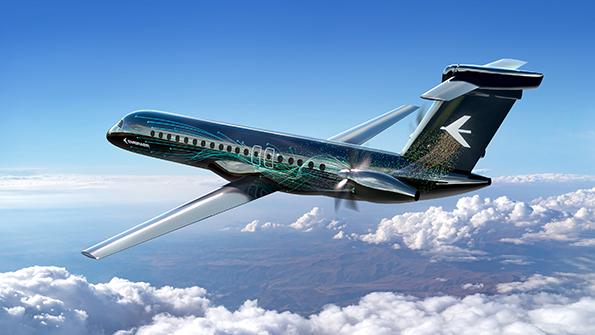

Embraer has unveiled a suite of sustainability initiatives that includes researching electric and hydrogen propulsion, planning new regional turboprop and hybrid-electric transport aircraft, and enabling its regional jets to use 100% sustainable aviation fuel.
The initiatives are among a series of environmental, social and governance (ESG) goals announced by the Brazilian manufacturer. They include committing to ensuring the company’s own operations are carbon-neutral by 2040.
- E-Jet E2s aim for 100% SAF use by 2030
- Regional turboprop planned for 2026-27
Unveiling the goals, Embraer also announced it has begun flight tests of an electric propulsion demonstrator, a modified EMB-203 Ipanema agricultural aircraft. With an electric motor and batteries replacing its piston engine, the demonstrator has been developed with Brazilian electric engineering company WEG and Portugal-headquartered energy company EDP.
After the flight-test program, Embraer plans to convert the Ipanema into a hydrogen fuel-cell propulsion demonstrator to fly by 2025. “It is a platform for us to advance technology,” says Luis Carlos Affonso, Embraer vice president of engineering, technology development and corporate strategy. “We want to test one of the E-Jets with hydrogen, but that’s a more ambitious project further down the road.”
For its current E-Jet E2 regional-jet family and business-jet product line, Embraer plans to work with suppliers with the goal of making them compatible with 100% sustainable aviation fuel (SAF) by 2030. “It is an aspiration, because it depends on other stakeholders, but we will drive to that goal,” he says.
As a next step, Embraer is working toward the launch of a 70-90-seat regional turboprop that will have 20-40% lower fuel burn and emissions than jets on equivalent routes. The company is looking for partners to invest in the program and accelerate development, aiming for service entry by 2026-27, says Embraer CEO Francisco Gomes Neto.
The turboprop has the same cabin cross-section as the E-Jets and, in its latest design, has the engines mounted on the aft fuselage, driving tractor propellers. This reduces noise and vibration in the cabin, is compatible with jet bridges and “is ideal to evolve with new propulsion solutions when they come along,” Affonso says.
In the early 1990s, Embraer led development of the CBA-123, a 19-seat regional with tail-mounted turboprops. While it never entered service, Affonso says he flew in the aircraft and it was “very quiet and did not vibrate—people did not think they were in a turboprop.”
Embraer is also preparing to launch development of the hybrid-electric Short Takeoff Utility Transport (STOUT) with the Brazilian Air Force. Powered by two turboshafts generating electric power to drive four propellers, the STOUT is a light military transport also aimed at the civil cargo market.
“We are ready to sign a contract with the Brazilian Air Force,” Neto says. “They are also ready, and we expect to sign next year.” The timing depends on the air force’s budget, but “we are ready to move,” he says. Embraer previously developed the KC-390 airlifter jointly with the Brazilian Air Force.
Under its commitment to achieve a 50% reduction in carbon emissions from company operations by 2040, relative to 2018, Embraer will begin using SAF for test, production and ferry flights this year and has committed to carbon-neutral growth from 2022 by capping its emissions at 2021 levels. The company’s Melbourne, Florida-based Executive Jets division already has begun using Neste SAF under an agreement with supplier Avfuel.
Jet fuel accounts for almost 70% of Embraer’s Scope 1 emissions from its own operations, and 38% of Scope 1 and 2 when emissions related to the purchase of energy are included. The company’s goal is to work with the supply chain to increase its use of SAF to at least 25% by 2040. Additionally, the company plans to increase its use of renewable energy to 100% by 2030.
Under the social pillar of ESG, Embraer’s goals include ensuring women make up 25% of its in-house aeronautical engineering masters program by 2025. The company has also launched a new Social Tech program to provide technology training to 1,500 people from minority groups by 2025, beginning with people with disabilities, says Carlos Alberto Griner, vice president of people, ESG and communications.
The new initiatives have been launched as Embraer’s latest financial results show the company is recovering from the dual blows in 2020 of the COVID-19 pandemic and the aborted merger of its commercial business with Boeing. “We had a very good second quarter,” Neto says.
Embraer now projects deliveries of 45-50 commercial aircraft and 90-95 business jets in 2021, he says. The commercial business is expected to be back to the pre-pandemic level of around 100 aircraft within five years, while the executive jet business grows to more than 120 aircraft per year in the medium term.

